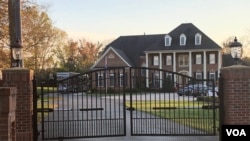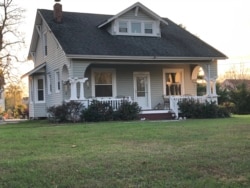Americans have long been drawn to big, open spaces, so perhaps it’s no surprise that houses built in the United States are among the most expansive on the planet.
And they keep getting bigger.
The size of the average house has more than doubled since the 1950s. In 2019, the average size of a new single-family home was 240 square meters (2,584 square feet), according to the National Association of Homebuilders.
Deeply held feelings about one’s home may be rooted in America’s homesteading, pioneering past.
“The appeal of the house for Americans, going back into the 20th century, was that it signified autonomy. You know, every home is a castle,” says Louis Hyman, an economic historian and assistant professor at Cornell University. “So, it has these echoes of signifying independence and achievement.”
The federal government has pushed the idea that a nation of homeowners is ideal.
The 1934 establishment of the Federal Housing Administration revolutionized home ownership. By creating the financial mortgaging system that Americans still use today, the FHA made home buying more accessible for millions of people. At the time, most Americans rented. Homeownership stood at 40% in 1934. By 2001, the figure had risen to 68%.
In the 1940s, President Franklin D. Roosevelt equated homeownership with citizenship, saying that a “nation of homeowners, of people who own a real share in their own land, is unconquerable.”
Today, the homeownership rate in the United States stands at around 65%.
The ability to invest in their homes has helped mask economic stagnation for many Americans. Although unemployment is near a record low, real wages — the number of goods and services that can be bought with money earned — haven’t budged in decades for U.S. workers.
“As Americans find that their wages are stagnating after the 1970s, they're able to make money by investing in houses,” Hyman says. “The houses become a way for average Americans to get financial leverage, which can multiply their returns. There's no other way for Americans to get access to financial leverage outside of houses. You can't do it in the stock market if you’re just a normal person, and so this is a way to basically speculate in housing.”
For some Americans, owning a big home is a status symbol, physical proof that they’ve succeeded in life.
“This kind of classical example of the big suburban home has been a very powerful idea for many, many decades now,” says architectural historian William Richards. “People sometimes want specific rooms that have specific functions —a mud room; everybody gets their own bedroom; there's no bunking up; a dedicated laundry room.”
And spacious houses are more financially attainable than they used to be.
“In the design and construction, there are greater efficiencies now for all sorts of reasons so that it's less expensive to build a bigger house now,” Richards says.
But do bigger houses, sometimes called McMansions, make people happier? Not according to a recent paper that Clément Bellet, now an adjunct professor at INSEAD, a European business school, wrote as a postdoctoral fellow.
“Despite a major upscaling of single-family houses since 1980, house satisfaction has remained steady in American suburbs,” Bellet writes in the report.
People living in larger houses, however, do tend to be more satisfied with their property, according to Bellet, but that satisfaction plunges when even more massive houses are built nearby.









